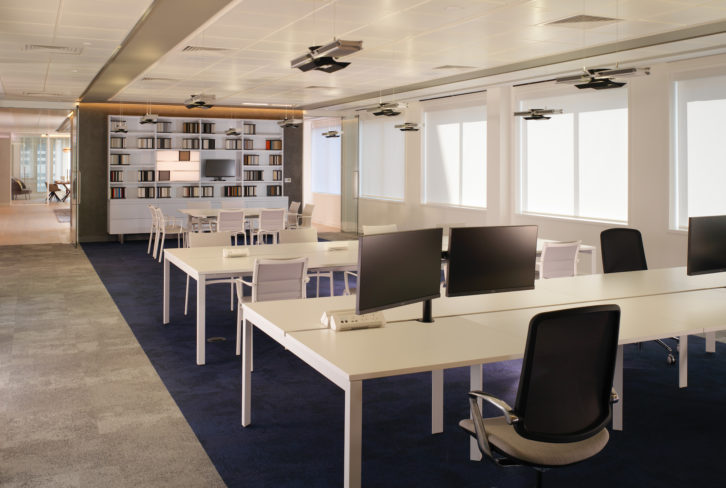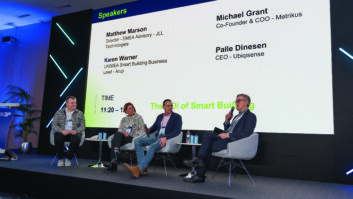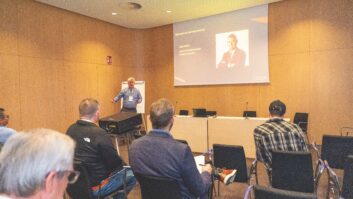
In the first part of this smart buildings feature we looked at the growing awareness of the possibilities offered by smart technology and highlighted the importance of getting independent service providers to communicate and work together on projects. Here Steve Montgomery considers universal building integration and the current trend to establish a human-centric approach.
Nic Milani, executive director for commercial product marketing at Crestron makes the point that: “With the current level of technology and ability to communicate the question often posed by building operators is ‘why isn’t every building smart?’. Sadly, the answer is that the commitment is often not there to achieve this. In large construction projects there are too many individual trades with separate specialists all concentrating on their own specific part for them to willingly combine without external effort. In any smart building deployment there will be several systems around, and they will all need to talk to each other, sometimes through intermediary devices, so there is often a ‘turf war’ going on; particularly when individual operators are focused on their section. Each is prepared to work with others but wants to protect their system, which is natural since it is their responsibility.”
Unique position
Success is often achieved when there is a committed building owner or leading consultant who make it a priority and drive integration of the separate systems. Milani adds: “The situation is changing, despite having failed for the past 10 years or so, as the world wakes up to what is possible and people are becoming more aware of the importance of sustainable business practices. We are in a fairly unique position in that our control systems can be used as a sub-system to the main BMS, receiving commands and controlling local devices. Or as a controller in command of a larger system that can take decisions and instruct other devices.”
This means that collaborative partnerships are important as Milani goes on to explain: “We have established working relationships with major building service suppliers like Johnson Controls and will support the projects they are involved in, as required, and without the need to take a leading role. This enables integration with the BMS and control of subsystems beyond the capability of a single system, so enhances the operation of the installation.”
Universal building integration is not limited to large new build properties. It is equally possible and desirable in smaller retrofit installations. Many systems now use standard IP network wired or wireless communication which negates the need to lay dedicated control wiring. They can also interact with users to give them local control of services using applications on their personal devices.
A current trend is to establish a human-centric approach for building operation. “The general movement toward intelligent buildings is applicable to both new and existing ones, with the ultimate aim of increasing interior comfort for employees and visitors and increasing productivity as a result,” says Rob Sinclair, account manager for building and performance sustainability at Siemens. “The operation of the building should be considered as an integrated whole. Occupancy and temperature sensors can be linked to the building management systems to control individual areas and locations to achieve the best operational mode for that time; whether by adjusting lighting and heating according to ambient conditions, switching equipment on prior to use or controlling window shades.
Adaptive systems
“Work habits are changing; people work out of the office and move around to a greater extent, so the control system has to be adaptive and reflect those conditions, providing the most comfortable and efficient environment. This has to be balanced with energy usage; it is not strictly correct to concentrate on reducing energy use to the absolute minimum at the expense of personal comfort.”
The proliferation of sensors means that there is an abundance of data. This is invaluable in monitoring the operational and health status of equipment enabling optimisation of operation and aiding maintenance and in streamlining the performance of a building. It can also be taken a stage further through amalgamation with other information from occupants’ personal devices over Bluetooth or wireless. This is highly valuable information. A universal dashboard can show instantaneous energy consumption as well as long term trends over single buildings or whole industrial complexes. It can also provide information to staff and engage them in managing energy efficiently.
Analysis of the usage of rooms can be very useful to building operators. For example by considering the average occupancy of a set of meeting rooms over a period can indicate whether there are too many or too few and expensive real-estate can be repurposed accordingly. It is also useful to detect wastage and raise alarms. “Sub-metering of individual devices enables an organisation to gain insight into where energy is used in a building and by what, helping to identify where energy is being wasted,” says Jonathan Luke, CEO of SenseLogix. “EnergyLogix hardware collects data across a wide variety of utilities including electricity, gas, water, heat, air and renewable generation and monitors both temperature and humidity. It can collect and collate data from different assets including lighting, plant, IT servers and racks, data centres, equipment, switchboards and final distribution and display it on a single, easy to use interface.”
Tremendous opportunity
There are many opportunities for AV integrators to become involved in these projects and expand their operations more widely. “There is a tremendous opportunity open to AV integrators,” says Milani. “They can engage with customers and elevate the smart building concept. They can use their integration and IT skills to embrace new solutions that include HVAC and energy management taking them beyond the AV control, lighting and security areas they are already familiar with.” He firmly believes that the technology available today is appropriate and sufficient although it is necessary to approach opportunities with caution: “We should be discerning about who we work with and aim to use available resources wisely; to provide standard solutions and to simplify installations in order to reduce risk and lower complexity.”
AV integrators have a part to play in the exciting and expanding world of building automation; should they choose to take it. The Continental Automated Buildings Association (CABA) is a leading international industry organisation that promotes advanced technologies in homes and buildings. Its 380-strong corporate members and 27,000 industry contacts are leaders in advancing integrated home systems and building automation worldwide and include most of the major organisations active in the sector. In a recent white paper entitled ‘Creating a New Deal for Buildings’ the organisation investigated the building automation market and concluded that: “We believe that the relationship between building owners and building vendors is currently broken, especially in the area of how building automation systems and rapidly multiplying IoT devices are used to improve the value and utility of facilities.”
The paper goes on to suggest solutions: “We believe that by enhancing this relationship, both enterprises and people who occupy buildings will reap significant benefits. It is time for vendors and owners to take action, and demand that the design and construction process enable owners and occupants to benefit from the type of technology, products, and services that can unlock the full potential of buildings for the 21st century and beyond.” Opportunity indeed.
www.caba.org
www.crestron.eu
www.senselogix.com
www.siemens.com







